Knowledge Library
Welcome to your go-to hub for all things platform engineering. Dive into expert insights with our blog, explore in-depth resources in our library, tune into inspiring conversations on our podcast, and watch engaging videos packed with valuable tech knowledge.

The tech industry is not having a great time at the moment. The 5 US tech giants – Microsoft, Google, Apple, Meta, and Amazon – have reported losses in 2022 for the first time in years, and announced massive job layoffs. Of course, they’re by no means going bankrupt, still having earned a combined $243 billion, but seeing as this figure is slightly lower than in 2021, this is sending executives (and the tech industry as a whole) into panic mode (as if it’s not at all a sign of people getting fed up with living in late-stage capitalism).
With major companies bringing back efficiency and profitability, more and more businesses are talking about squeezing budgets in light of the cost of living crisis and the slowing global economy. If you’re considering cutting excess weight in your spreadsheets, here’s a suggestion – why not take a look at your cloud spending?
If 2023 is supposed to be “the year of efficiency”, optimizing your cloud usage is one to start. Not only do cloud costs make up almost 41% of the IT budget according to Gartner – meaning cutting it would make a real difference to your overall finances – in most cases, a lot of the cloud ends up being wasted. Our founder Benjamin Brial has written on the subject of cloud waste before, but the TL:DR is this: despite the cost of the cloud going down, companies’ spending on it has doubled in the last few years, with over $26 billion wasted on inefficient cloud usage. For a hyper-efficient IT world, it’s terribly below the mark.
If any of this rings true, don’t despair – there are ways to cut your spending and optimize cloud usage.

Get good FinOps software to track your costs
One of the reasons cloud spending keeps rising is the fact that cloud costs are shrouded in complexity and mystery, and traditional ways of monitoring them just don’t cut it anymore. Tracking with spreadsheets can get really complicated really fast while chasing data around multiple cloud cost management solutions across your cloud providers is already unnecessarily complex and can mask the real culprits.
What you must be looking for in a FinOps tool is the level of data granularity. You must be able to see the cost breakdown by project, region, provider, date range, or even team, to identify blindspots and money suckers, which would normally be overlooked.
Centralization and ease of access also play a part: the faster you can get a bird's eye view of your cloud usage, the easier it is to correct course in case of errors. Marketing departments have ruined the word “holistic” for the world, but it’s exactly what you should be aiming for because getting the big picture, trends, and predictions for cloud resources can be the real missing piece to your financial strategy.
This is perhaps where we could plug our own FinOps module Cloud Cost Management, which does all of the above, but the consumer choice is really up to you – we can only advise on what to look out for.
Resource management
.png) If your developers are enjoying the benefits of a self-service portal, resource management and access controls are a must. When end-users are servicing themselves, it’s really easy to spend more on cloud resources than you initially budgeted for, so it’s best to use a quota system.
If your developers are enjoying the benefits of a self-service portal, resource management and access controls are a must. When end-users are servicing themselves, it’s really easy to spend more on cloud resources than you initially budgeted for, so it’s best to use a quota system.
Think about setting up resource limits in advance and assign quotas to teams to make sure they keep to the budget. Additionally, providing cost visibility to end-users directly can help them make more conscious decisions and foster a culture of independence and transparency.
Understanding the consequences of these specific decisions and calculating the impact they will have on the bottom line, ahead of time, is critical. For example, a cost estimation feature built into your self-service portal will let your end-users know the cost of their new deployments in advance so that they manage to keep within budget constraints. TerraCost, Cycloid’s open-source project uses your Terraform plan to automatically display the cost of a new environment before it’s deployed and can be used by any self-servicing team.
Reduce cloud waste with a sobriety mindset We’ve mentioned before about cloud waste, but the real change goes beyond just using the right tools - it requires a mindset shift across the whole organization. Some more horrifying statistics: according to the HashiCorp State of Cloud Strategy Survey, 40% of companies overspent their cloud budgets in 2021. This means that nearly half of all companies don’t make enough of an effort to promote healthy cloud practices in their organization or monitor cloud consumption.
We’ve mentioned before about cloud waste, but the real change goes beyond just using the right tools - it requires a mindset shift across the whole organization. Some more horrifying statistics: according to the HashiCorp State of Cloud Strategy Survey, 40% of companies overspent their cloud budgets in 2021. This means that nearly half of all companies don’t make enough of an effort to promote healthy cloud practices in their organization or monitor cloud consumption.
For far too long businesses have viewed the cloud as an unlimited resource needed to drive progress forward with no regard for the financial and environmental costs. While it still is a major driver of technological growth, there are ways to use it more efficiently – and it starts with a change mindset.
Adopt sobriety practices: turn off infrastructure during the weekend. Empower your end-users to make informed decisions about the amount of cloud they’re using and its impact. Stop over-provisioning resources.
An additional bonus of looking after your cloud usage is its lowered impact on the environment and reduced cloud carbon footprint – a lovely pat on the back for your organization and team.
Buy in bulk
Reserved instances are a great way to get major discounts on your cloud and save some cash. If your business has a steady workload, you can simply commit to a cloud volume over time and get over 50% in discounts. This will depend on the amount and length of the commitment, as well as how much you need to pay in advance, but it’s a great way to “deploy within your means” and stop overspending.
Most major public cloud providers already offer various options for reserved instances, but before you run and stock up, think about vendor lock-in.
Consider multi-cloud to avoid vendor lock-in
AWS, Microsoft Azure and Google Cloud are all also facing slowing profit margins, so their main goal is to entrench themselves with the customer or in other words, lock them in. According to Financial Times, AWS is offering big discounts to clients that use them exclusively potentially squeezing out smaller competitors. Terms like “preferred cloud provider” or “all in” are designed to make you commit to spending a large amount of money without considering other cloud providers.
While discounts are great in the short term, using a single cloud vendor may not be the best option for your business long-term. We prefer not to put all our eggs in one basket, because a hybrid or multi-cloud approach strives for flexibility, agility, and speed, which will not only address the cloud cost concerns but also help your business be more profitable in the long run.
Cloud cost optimization is an ongoing project
Optimizing cloud usage should be happening continuously at all levels of business to achieve the best results. This is not the case of implementing cost-saving strategies once - your cloud costs must be constantly monitored, analyzed and practices improved to boost efficiency.
Even though things might be tough, and for most major companies employees are the first ones on the cutting block, the more forward-thinking businesses should first look at their inefficient processes and tools before initiating big layoffs.
At the end of the day, taking better control of your cloud spending and consequently, cloud carbon footprint will have a positive effect on your accounts and the environment.
{{cta('da7d1a6d-80dd-41a7-8811-0ffaef8d457e','justifycenter')}}
...Platform engineering is becoming an increasingly popular approach to software delivery because it offers benefits such as improved time-to-market speed, increased developer happiness, and breaking down of team silos. We wrote extensively about platform engineering, specifically that it’s not, in fact, new and DevOps is not dead. However, given how many enterprises have struggled with delivering DevOps business value, they might view building internal digital platforms to aid software delivery as an actionable plan to achieve everything DevOps ever promised.
But how do you avoid falling into the same trap that held 80% of companies back from adopting DevOps?
Our advice: treat your platform like an internal product, and your wider teams as your customers. This means that your success metrics should be the same as you would use for your customers - with a platform engineering twist.
Key goals of Platform Engineering
When setting up your success metrics, it’s important to not lose sight of what your Platform Engineering strategy should aim for. According to the 2023 State of DevOps report, these were the top goals companies set for their platform teams.
Educating and empowering developer and product teams is a major priority for platform teams, followed by iteration speed and security processes. This people-centric approach is the same one you should adopt in your metrics. Reinventing tools is only half the job - you need to make sure your people are comfortable using the new frameworks. Streamlining and automating processes according to DevX best practices helps the entire organization move more quickly and drive a competitive edge.
Platform Engineering KPIs
According to the 2023 State of DevOps report, after adopting Platform Engineering, the majority of enterprises saw improvements in system reliability (60%), productivity and efficiency (59%), and workflow standards (57%), while 42% reported improved development time.
Productivity
Measuring lines of code produced by developers in X amount of time is an outdated metric used these days perhaps only by the likes of Elon Musk. Developer productivity is a sensitive subject, and while platform engineering promises to speed up software development, it doesn’t happen by making developers deliver more.
Instead, it’s about creating the best conditions for your devs to thrive in. Think about the bottlenecks and obstacles that your teams have to deal with daily and how much they have to rely on experts to get their work done. Complex infrastructure deployments, creating new environments, shipping features - all these require DevOps help, which inevitably clogs up processes. KPIs centered around streamlining and simplifying the software delivery process should be your focus.
- Lead Time
This is a measurement that tracks the time from when a user story is initiated to when it’s ready for delivery. This time can also include discussions about the user story, how long it was waiting in the backlog, and how much time it took the story to move from pickup to release.
If your lead time for changes is too high, it’s a clear sign of a roadblock somewhere in your processes, causing items in the backlog not to move along. Automating whatever could be automated will help keep your lead time low, as it shows your teams are quick to adapt to feedback and deliver on their goals.
- Deployment Frequency
High deployment frequency shows that your team can make frequent changes to code and make it live — with little fuss and delays. The easier time your end-users have deploying new infra, the faster it's going to happen. Consequently, this lagging indicator shows that your development teams are efficiently adopting continuous integration and continuous delivery (CI/CD) practices, deploying small pieces of code frequently, and having a solid grasp of the infrastructure
- Developer Happiness
Stability
Stability measures your ability to enable product engineers to make changes confidently and without breaking the end customer experience.
- Change Failure Rate (CFR)
By monitoring this metric over time, you can get a good idea of how much effort goes into addressing problems and how much goes into releasing new code. When it’s above 15%, your teams are probably spending too much time fixing problems. This means they could be more productive elsewhere, or some processes need to be improved.
- Mean Time to Recover (MTTR)
Even the best DevOps teams experience unanticipated downtime and issues from time to time. You can’t stop failures from happening — but you need to know how long it takes to get things back up and running after they do.
Efficiency
Productivity and efficiency often get grouped in the same category, but we want to specifically look at cost-effective efficiency metrics, which include the cost of cloud resources, infrastructure, and licenses, as well as the cost of platform engineering teams. Platform engineering is all about the efficient use of resources, so FinOps and GreenOps modules would benefit your resource strategy.
- Resource allocation
- Cost observability
Knowing where you spend your money will help you catch overrunning cloud expenses and waste. As we’ve already mentioned, resource efficiency is one of the pillars of platform engineering, and that’s why we encourage companies to take a sober approach to their cloud consumption.
Transparent cost KPIs will help you achieve this goal. Giving end-users and platform teams alike the ability to see the cost impact of their architecture designs before deploying or a holistic overview of all cloud expenses will be the make-or-break element in your success.
Platform Engineering KPI dashboards
Many of these KPIs have a shared responsibility between teams - keep this in mind when visualizing your metrics. Transparency and observability are one of the things that contribute to breaking down team silos, so shared comprehensive KPI dashboards are something to consider. Consider, for example, what KPIs look like at Cycloid:
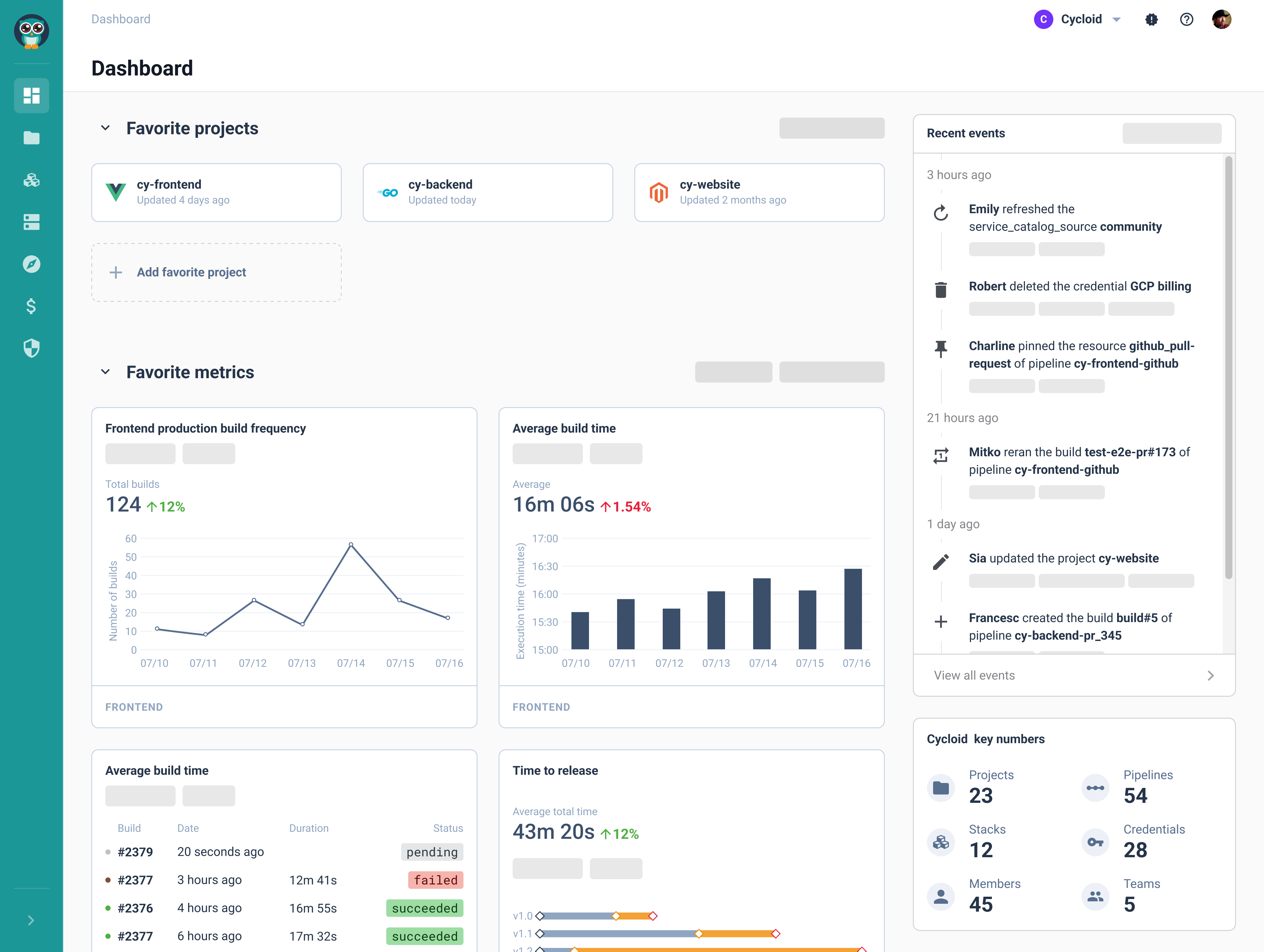
Bottom line
Given that a third of platform teams are still struggling with the wider team’s resistance to platform adoption, keeping an eye on your adoption progress should be among your wider KPIs. After all, a platform is meant to benefit the whole company and bring teams to work closer together, and that requires cooperation on all sides.
No matter which metrics you choose, it’s important to set realistic expectations within the company during the early years of platform team adoption. Your KPIs will evolve as you move through your Platform Engineering journey, but in the early stages, you should focus on making it much easier for platform and product teams to ingest their data and make it actionable.
Curious about Cycloid Platform Engineering? Get a personalized demo from our team:
{{cta('2fa281d7-afe7-428b-94b2-6e02f8188729')}}
Cycloid is proud to present Cloud Carbon Footprint, our own cloud carbon emissions module integrated with our established FinOps solution. We’re taking a unique GreenOps + FinOps approach to monitoring cloud computing emissions by connecting your emissions data to your cloud expenses so you see both costs to your budget and the cost to the environment in the same place. We’re hoping this approach will promote a culture of sobriety, where companies will start making more environmentally conscious decisions by reducing the amount of cloud waste.
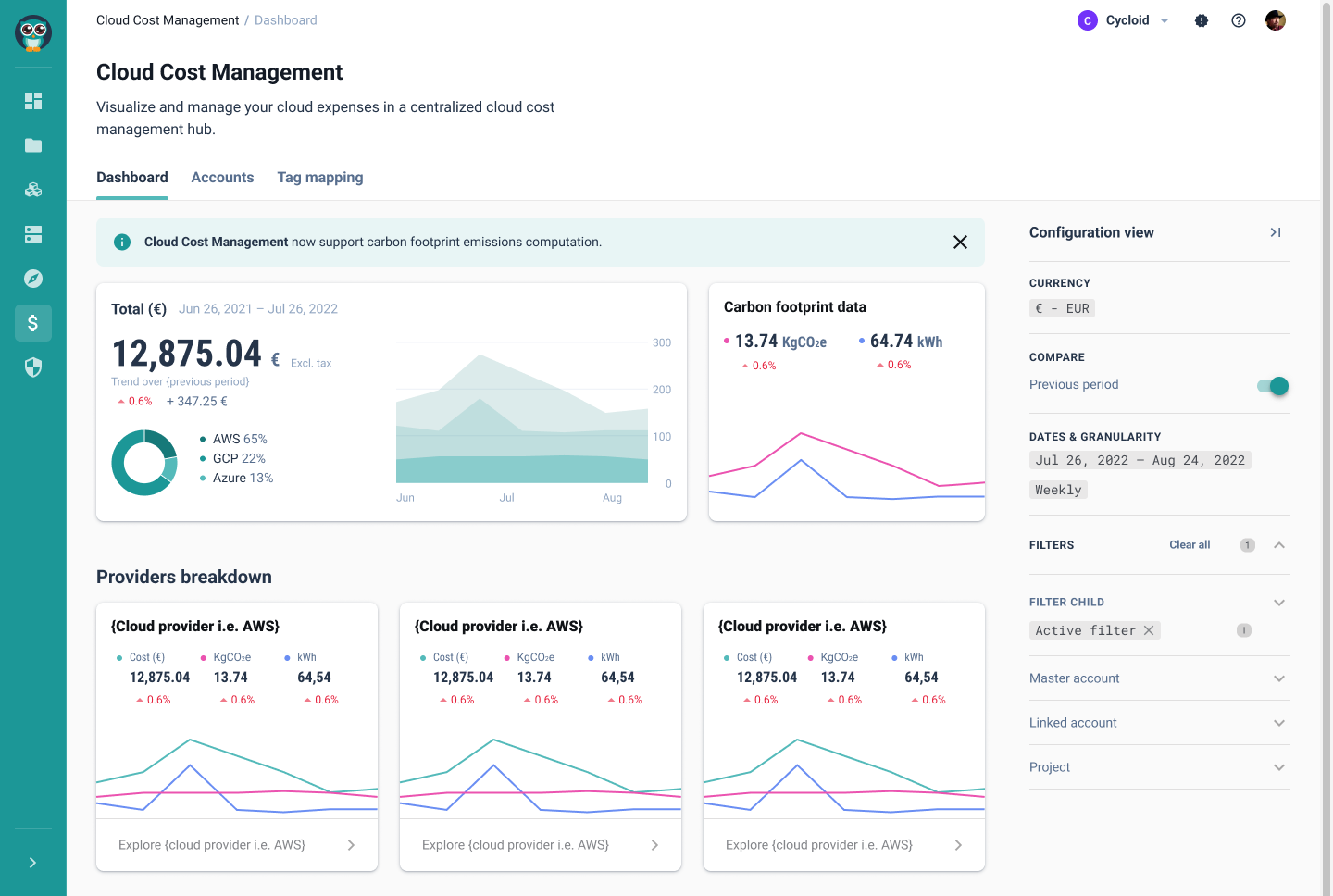
The cloud is not a cloud
Most people seem to forget that “the cloud” is not a cloud at all, but rather a series of massive concrete buildings full of servers that need constant cooling. It’s not hard to guess that the combined electricity required to run these servers amounts to a large carbon footprint that has huge consequences for the environment. In fact, cloud computing carbon emissions range from 2.5% to 3.7% which exceeds emissions from commercial aviation (2.4%), and, as the world’s going more digital, this number is only going to grow. There is no doubt – companies that engage in cloud computing need to start taking real steps toward reducing their cloud carbon footprint. This is where Cycloid’s new solution comes in.
Cloud Carbon Footprint in detail
Cycloid’s newest GreenOps module is an integral part of our FinOps solution – Cloud Cost Management. It displays carbon footprint data alongside your cloud costs and allows you to get a holistic view of both your cloud consumption and its environmental impact. Our goal was to address 3 main issues organizations have when it comes to managing their cloud carbon footprint:
- Real data and visibility;
- Understanding data in human terms;
- Clear course of action.
Watch the product demo
Precise cloud carbon footprint data
Cycloid’s Cloud Carbon Footprint management uses sophisticated emissions methodology based on Cloud Carbon Footprint open-source project. We took a bottom-up approach where we use the atomic cloud resources usage calculated against cloud energy conversion, power usage effectiveness, and grid emissions metrics. This methodology is best explained in the graphic below.
This methodology allows having fine-grained information on all dimensions, including time, projects, environments, clouds, services, etc. to track exactly what is needed.
This data is then displayed next to your cloud cost data and can be filtered the same way as your cloud expenses - by provider, project, date, region, etc.
Real-world equivalents
Now that you have all the data on hand, you can finally start walking the walk when it comes to cloud sustainability… Wait, but what does 298.33 kgCO2 actually mean? Is it too much or too little? How sustainable is your cloud consumption?
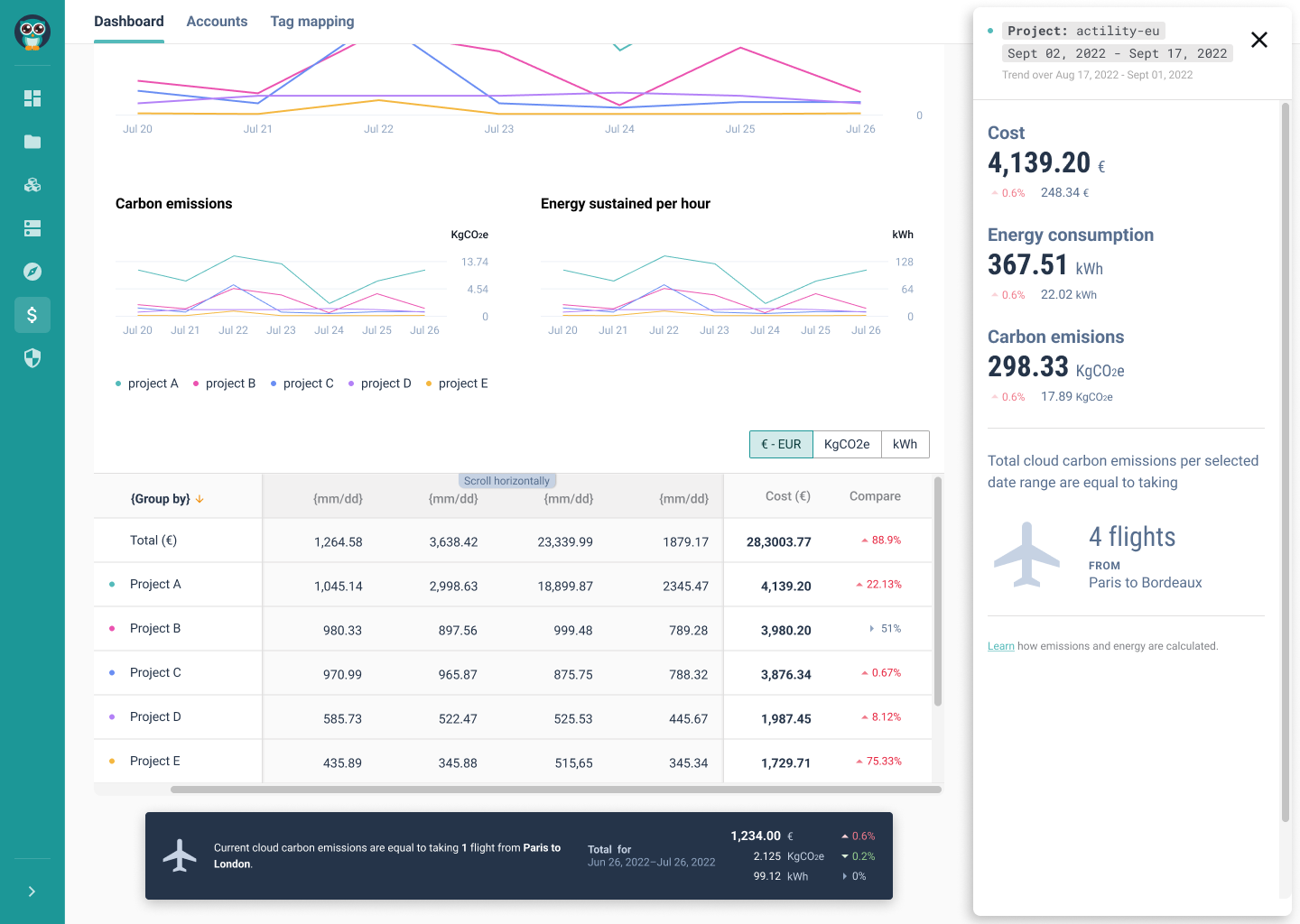
Most people are not yet well-versed in the intricacies of carbon footprint calculations, which is why the Cloud Carbon Footprint module includes human equivalents for each data point. For example, 298.33 kgCO2 is equivalent to taking 4 flights from Paris to Bordeaux. Makes you think about your traveling habits as well as cloud consumption, doesn’t it?
Consume less, spend less
At the heart of Cycloid’s sustainability principles lies the concept of sobriety – consume less, spend less. After all, no matter how “green” and sustainable some datacenters options may seem, the only way to make a real difference to your cloud carbon output is to use less cloud.
According to Gartner, in 2022 companies generated $26.8 billion in cloud waste – which means all of those servers were paid for and engaged to run… nothing. Not only is this a major waste of money, but also a huge waste of the planet’s dwindling resources and goes against any cloud sustainability principle.
By giving organizations an opportunity to look at real carbon emissions data, we hope we can inspire them to make better, more environmentally-friendly choices. Don’t leave servers running over the weekend. Only use the resources you need. Take a closer look at your cloud spending and optimize cloud usage.
This will benefit not only the environment but your budget – and especially now, as the tech bubble is bursting and the world is going through yet another financial crisis, the cost is not the least important on your list of priorities.
Final word – GreenOps is non-optional
Cloud Carbon Footprint is the only Cycloid feature that you cannot turn off (and that’s a pretty big deal). Here at Cycloid, we pride our platform on the flexibility of choice – you can pick and choose modules and assemble an opinionated custom platform that will do exactly what you need it to, no more, no less. By making GreenOps non-optional in our FinOps module we’re taking a stance against cloud waste, overspending, and mindless cloud consumption. This will encourage organizations to start thinking about the environmental impact of their business. Cloud Carbon Footprint will not solve climate change – but for many, it will be the first step toward conscious consumption.
If you’d like to support this stance and take your cloud consumption under control, click the button below to arrange a personal demo and our team will take you through our Cloud Carbon Footprint solution.
{{cta('2fa281d7-afe7-428b-94b2-6e02f8188729','justifycenter')}}
...
Platform engineering is taking the IT world by storm. We’re seeing articles claiming that platform engineering is finally going to end the DevOps reign and achieve everything DevOps never could – agility, automation, developer experience, efficiency and governance. The path to IT transformation and business growth that the new trend paints through self-service seems so painfully obvious, but let us tell you a little secret – it is not new. The trend might be a fresh marketing buzzword, but forward-thinking companies have already been utilizing the benefits of a platform engineering approach. Today’s platform teams are tasked with exactly this: building and maintaining an internal developer platform that connects the end-user to infrastructure management through simple developer self-service and improves efficiency and developer experience.
This idea has been working in practice for a while -- and we should know, since improving operational efficiency through a developer platform with self-service is Cycloid's core offer. We've recently used platform engineering to help our client Alchemy scale their automation and move infrastructure to Kubernetes on AWS.
Here’s what we did step by step:
Step 1: Take an Opinionated Approach to the Development Environment
Kubernetes clusters are a great option for enterprise applications and scaling on the fly, however they require vast specialist knowledge to set up. The team expressed a need for a self-service environment that would abstract away the Kubernetes complexity. Here’s what they were looking for in the platform:
- Everyone can deploy Kubernetes automation regardless of skill level
- Easy switching between organizations for different clients
- See and control how much they’re spending on the cloud
- Control deployment progress in CI/CD pipelines
Step 2. Adopt an engineering platform
The beauty of an engineering platform is that it gels together and centralizes all of the features and services you need -- like governance, deployment and operations. An engineering platform strives to achieve three things:
- enable developer self-service
- boost effectiveness and productivity by automating repetitive tasks
- enhance developers’ and end-users’ experience of working with the infrastructure.
Not only does the Cycloid Engineering Platform provide a self-service portal that allows to automate and use Kubernetes clusters with ease, but it also completes the solution with modules around governance and FinOps in a full GitOps approach.
“As developers, we loved being able to operate the application in a simple way. It’s based on GitOps so we aren’t locked to any one service and embeds open-source solutions natively - which, being based on open-source Phraseanet, we really appreciated”, says Alchemy CEO Guillaume Maubert.
The diagram below describes the benefits of a platform engineering approach:
Scale Kubernetes automation through an engineering platform:

Step 3. Build the Stack
Building a service catalog means being able to reproduce environment parameters for each new deployment without having to build it from scratch. This allows devs without specialized experience to simply choose approved and suitable infra configurations and save loads of time on deployments. It encourages the use of best practice in a full GitOps approach – without the need for time-consuming tech supervision. You only need to set it up once, and Kubernetes complexity just isn’t a problem anymore.
Cycloid’s service catalog is called Stacks and our DevOps team helped them build the first two.
First one would allow Alchemy to create AWS EKS (Elastic Kubernetes Service) cluster and external services.
The second application Stack was created to make it possible to deploy all their applications inside an AWS EKS cluster and configure them to use AWS services.
Alchemy is using the following AWS services after migration:
- Elastic Compute Cloud
- Simple Storage Service
- Elastic File System
- Backup
- Relational Database Service
- OpenSearch Service
- CloudWatch
- ElastiCache (redis)
- Elastic Load Balancing
- Data Transfer
- Route 53
- Virtual Private Cloud
- Elastic Container Service for Kubernetes
- EC2 Container Registry (ECR)
Step 4. Get the best developer experience with self-service
Once the Stacks are set up and automation configs are ready, Alchemy developers are free to configure new environments in a self-service portal called StackForms. Cycloid’s self-service looks simple: it’s a regular webform with dropdown menus and toggles for ease-of-use. Developers can now simply select the relevant Stack, choose variables and hit run – it’s that easy.
.png)
How self-service improves DevX:
- Fast and efficient deployment
- User-friendly UX
- Built-in governance
Cost Estimation on the side lets the developer know how much each new environment is going to cost before it’s deployed. It fosters autonomy, independence and business responsibility, while also improving developer experience.
Step 5. Enjoy business acceleration
Where previously setting up a new Kubernetes cluster on AWS could easily take more than a day, with Cycloid’s self-service, it only takes 5 minutes! Taking into consideration the 30 minutes AWS needs to provision the new infra, and you’ve got a new environment in less than an hour!
But the beauty of platform engineering with a self-service core doesn’t stop there. Since Alchemy works with multiple customers, the Cycloid platforms allows them to switch between them easily while still being able to apply the same service catalogue to their projects. The platform’s built-in governance features pre-define minimal user privilege, ensuring compliance but allowing exactly the right amount of flexibility individuals need to do their job.
In the near future Alchemy is looking at utilising the capabilities of Cycloid’s built-in FinOps module that centralizes cloud costs in a single panel which you can view by provider, project, region, client etc. This would allow them to take better control of their Kubernetes deployments on AWS and possibly expand to other cloud providers – we’ve written about the benefits of hybrid cloud extensively.
Platform Engineering for the win
With a self-service portal and controlled flexibility, we were able to find the right balance. On one hand, developers get a simple interface that abstracts away the unnecessary details of the underlying infrastructure. At the same time, the platform team has a full degree of flexibility to deploy any automation in a matter of minutes and in the process simplify one of the most complex and tedious DevOps tasks.
If you’re now establishing a platform engineering strategy, starting with a tried and tested platform would help you avoid reinventing the wheel and get started on your IT transformation journey quickly and painlessly.
{{cta('2fa281d7-afe7-428b-94b2-6e02f8188729')}}
...COP27 took place in Egypt last month, the latest in the series of conferences that bring the global community together in the hope of agreeing on action to mitigate the climate emergency. Many ecologists have questioned how helpful these endless meetings have actually been. Although getting everyone around the table is an important first step, the gathering has received criticism for promoting an all-talk, no-action approach to climate change.
We all have a duty to tackle climate change, and in order to achieve the ambitions set out by successive COP meetings, businesses now need to begin laying the foundation for reducing their cloud computing emissions across every organization. Whilst improving efficiency and digitalizing operations bring with them environmental benefits, IT departments themselves don’t always have visibility over their own carbon footprint. If we are to build a foundation upon which to meet green objectives, this needs to change.
With GreenOps, organizations can massively improve their visibility into the environmental impact of IT operations, putting decarbonization at the heart of decision-making.
At its most basic, GreenOps is a framework for organizations to start understanding the environmental impacts of their IT strategies. Think of it as FinOps, a framework for managing operational expenditure, but for the planet. At the same time, it empowers organizations to promote environmental responsibility at every level through data-driven decision-making and insights.
You can read more about GreenOps here, but the bottom line is that it gives organizations of any size the ability to start taking data-driven decisions to decrease their carbon footprint.
A fair question often asked of proponents of GreenOps is: can we really expect businesses to make more expensive decisions for the sake of the environment? Certainly, in our current economic climate, there is a need for much more sobriety in spending across all industries, so it is a challenge to pick green options over cheaper alternatives. However, if COP27 has shown us one thing, it is that the time to act is now.
Like the decisions at COP27, nobody can guarantee that greener choices will be the easier choices. In fact, many environmentally friendly options are often more expensive and time-consuming than those which cause larger emissions. However, businesses must avoid just “talking the talk” about tackling the climate emergency if they have no intention of putting it into action. GreenOps acts as a fantastic foundation for greener business practices; businesses that are serious about acting more than talking when it comes to environmentalism should look to implement it as a priority.
Would you like to start walking the walk when it comes to your cloud carbon footprint? Cycloid's on a mission to give businesses full visibility over their cloud carbon footprint. Knowledge is the first step to taking action. Subscribe to be in the know and tackle climate change now.
{{cta('da7d1a6d-80dd-41a7-8811-0ffaef8d457e')}}
...If you’ve been around Cycloid socials, you’ll know that we’ve had a quiet change of name - from Cycloid Hybrid Cloud DevOps Platform to Cycloid Platform Engineering. Besides the fact that the new title is less of a mouthful, it’s also a better reflection of what we do here at Cycloid. We are not having a sudden change of heart and reimagining everything the Cycloid platform does - quite the opposite. The core principles of the emerging trend of platform engineering are aligned with the vision Cycloid has been bringing into the world of DevOps and hybrid cloud since its conception - so the soft rebrand was in order.
In a recent article, Gartner described platform engineering as a strategy aimed at “improving developer experience and productivity by providing self-service capabilities with automated infrastructure operations.” This term is trending because of its promise to accelerate product teams’ delivery and increase business value.
Cycloid’s core focus is enhancing developer experience and improving operational efficiency. We’ve seen the need for DevOps and developed a concrete and practical way of achieving it - by enabling developer self-service and opening up DevOps and hybrid cloud adoption to everyone. Platform engineering is simply another word for something we’ve been doing for a long time.
But with this shift towards platform engineering as Gartner predicts, new questions come up - does this mean the end of DevOps? How does platform engineering align with hybrid cloud management? Let’s take some of your most burning questions.
What is Platform Engineering?
.jpeg)
Platform engineering is the solution to the central problem of frictionless collaboration between developers (end-users) and platform teams. Today, forward-thinking companies are already establishing platform teams that deal with precisely the objectives platform engineering aims to tackle - and Gartner identifies the following:
- enable developer self-service
- boost effectiveness and productivity by automating repetitive tasks
- enhance developers’ and end-users’ experience of working with the infrastructure.
Companies that have begun to build an internal platform that offers to connect end users and ops through a series of high-quality building blocks - a self-service portal, RBAC and cloud governance, FinOps, etc. - are already seeing positive results. Gartner predicts that by 2026, 80% of companies will establish platform teams as internal providers of reusable services, components, and tools for application delivery.
Why should you care?
In a nutshell? Platform engineering accelerates software delivery and boosts business profitability by focusing on 3 major areas of improvement:
- breaking down team silos
- increasing developer happiness
- rolling out DevOps
An operating platform that sits between the end user and the infrastructure which they rely on will end the “over the wall” mentality and open up the software delivery process for everyone in your organization.
Platform engineering creates a culture of transparency where your developers can self-service infrastructure to design, build, and deploy while also being able to estimate the financial impact and manage resources all on their own. The platform team can focus on designing, building, and maintaining their own opinionated platform and the service catalog with all the automation and plugins needed in a GitOps approach, with a high-level view of project progress, tools, CI/CD, cloud, bottlenecks, and user roles with strongly enforced governance. Larger organizations can adapt the platform to their exact needs by developing plugins.
Finally, when no one is thinking it’s the other team’s problem, everyone shares the collective responsibility to find a solution and contribute to business growth.
Moreover, with infrastructure concerns out of the way, onboarding times for newcomers are significantly reduced. This means it will become easier to attract new talent as talented engineers like to be able to innovate without being held back by repetitive tasks - which, in the age of DevOps engineers shortage, is definitely something you’d want to consider.
Is Platform Engineering the end of DevOps?
If the aims and benefits of platform engineering seem suspiciously close to those of a DevOps approach, that’s because they are. We’ve seen articles that claim that Platform engineering is the death of DevOps supported by nothing but strong marketing - and that is simply not true. Platform engineering is not here to replace DevOps best practices, but to help enforce them. It is a clearer path to the beautiful world of self-service, continuous delivery and deployment, improving day-to-day operations, and flexibility that DevOps has been promising for over 10 years.
While DevOps is the dominating framework, 80% of organizations are still struggling to adopt it fully. The reasons for that are plenty - the main one being that DevOps describes a set of rules and best practices without a defined plan of action to achieve them in practice. This results in slower DevOps rollout as teams often aren’t sure where to start or which area to focus on first.
Platform engineering is a lot more on the nose. Today, platform teams already take on the challenge of building an internal developer portal that would answer their organizational needs and offer the right capabilities to enable developers and others to produce valuable software with as little overhead as possible.
In other words, platform engineering is DevOps dressed in a trenchcoat - same concept, different name!
How does Cycloid contribute to Platform Engineering?
Whether you already have a platform team or are just at the beginning of your internal platform development, Cycloid is designed to complete your internal solution with high-quality building blocks focused on specific DevOps and hybrid cloud best practices.
Self-service platform, cloud governance, RBAC, CI/CD pipelines, built-in FinOps, and GreenOps are all modules that you can pick and choose to complement your internal solution or begin your digital transformation. Like a piece of a puzzle, Git-based and lock-free Cycloid can fit into your organizational strategy and solve the burning issues at hand.
Platform engineering may be a fresh trend, but the strategy of improving operational efficiency through a developer platform has been our bread and butter for years.
Contact our team to build your own opinionated platform with Cycloid’s platform engineering modules to improve governance, deployment, operations, and FinOps.
{{cta('2fa281d7-afe7-428b-94b2-6e02f8188729')}}
...
With COP27 just around the corner, the world is once again set to come together to try to
find a solution to the climate emergency. Given the heat we saw this summer in Europe, it’s
fair to say that urgent action needs to be taken, not just by governments or those in the
energy industry, but by all of us. The IT world is no different and has its own role to play –
for those of us working in IT, that role comes partly in the form of adopting GreenOps. So
what is GreenOps, and why does the world need it?
According to the University of Oxford, a single standard desktop computer operated over a
period of 6 years produces an annual carbon footprint of 778kg of CO2. Emissions from cloud computing are often overlooked, but they actually range from 2.5% to 3.7% of all global greenhouse gas emissions, thereby exceeding emissions from commercial flights (about 2.4%) and other existential activities that fuel our global economy.
At its core, GreenOps is a framework for organisations to start understanding the environmental impacts of their IT strategies, whilst simultaneously promoting environmental responsibility at every level of the enterprise. Think of it as FinOps, a framework for managing operational expenditure, but for the planet.
The big challenge faced by those implementing GreenOps is that making an entire IT
ecosystem sustainable requires a big overview of the environmental impact of every
single area of an IT operation. For that reason, if GreenOps is going to work, it needs the
collaboration of everyone across an organisation, from the IT department right through to
HR, marketing and accounting. All of these individual departments must set business
requirements, determine software development and DevOps processes, and adhere to
operational principles. For this to happen, there needs to be a shift in mindset amongst IT
Managers and leaders to become part of the broader conversation on sustainability.
Once every employee, at every level of an organisation, understands that they have a role to
play in reducing their business’ carbon footprint, then the company as a whole can take its
first steps toward realising combined sustainability and IT goals.
So how does this happen?
Making an entire IT infrastructure go green means making sustainability a core principle.
Setting decarbonisation as a KPI alongside revenue growth, profit margin and customer
satisfaction is key to embedding environmentalism in an organisation’s corporate culture.
That’s not necessarily going to be an easy process, especially as many IT suppliers claim to
be sustainable without quantifying what that actually means. Thankfully, one sure way to
create a greener IT offering is to look to digital technology.
Digitalisation presents an opportunity for a more sustainable world by making processes
more efficient, but it doesn’t come without its own challenges – the more sophisticated
digital solutions become, the more resources they consume. The bottom line, when it
comes to GreenOps, is that there is no “one size fits all” approach. When it comes to cloud
services, which can undoubtedly help to reduce an organisation’s carbon footprint, it’s
important that IT teams have the right tools to determine when cloud services are being
used inefficiently, and how to rectify that to cut out waste. As with any kind of IT decision,
ensuring that an organisation maximises its efficiency is good for its financial situation, but
through the new lens of GreenOps also makes sense from a sustainability standpoint.
GreenOps is a critical part of the wider societal journey toward a more sustainable future.
With the renewed focus on our environment during COP27, and the increasing realisation
that we are in a climate emergency, it is crucial that IT leaders recognise their part to play in
decarbonisation.
Subscribe to Cycloid to get updates about about decarbonisation efforts, industry updates, DevOps, hybrid cloud and more right in your inbox!
{{cta('da7d1a6d-80dd-41a7-8811-0ffaef8d457e')}}
...Amidst the Great Resignation, DevOps talent shortage and the looming global economic crisis, retention of skilled and passionate professionals will continue to be a priority for IT businesses in 2022. After all, skill and talent gaps remain the top hurdle for business transformation, according to DevOps Institute Upskilling Report 2022 that Cycloid co-sponsored. But where do you find the right talent? How do you harvest the much-needed skills?
If you’re familiar with anything that Cycloid does, you know what we’re going to say: upskilling. We maintain that you won’t need to hire an army of DevOps engineers - just a few great DevOps and your best dev team is all that’s necessary to start a DevOps revolution.
Our DevOps and hybrid cloud platform facilitates natural upskilling in your organization and helps all your non-DevOps teams - like developers, managers, FinOps, security, and solution architects - gain DevOps-like abilities in a discreet, straightforward manner. If you already have a dedicated upskilling program (congrats, you’re better than 49% of global IT organizations!), Cycloid can be a great second fiddle to your education efforts, giving your devs space to apply theoretical knowledge in practice.
Here’re a few things we believe in - and a few tools that smooth the way for your upskilling strategy.
Fostering autonomy and independence
The success of your DevOps upskilling efforts is measured by how much work your non-DevOps team can do without involving DevOps experts. Your DevOps team has much better things to do than babysitting developers, like setting up automation, evangelizing, and managing resources. The good news is with a little help, your devs can take the majority of tasks off their plates by servicing their needs independently and interacting with infrastructure modules without extra help.
Self-service portal
.png)
We bang on and on about our self-service portal StackForms, but the truth is that it is crucial if you’re encouraging your devs to “shift left”. Remember - don’t them off the deep end, but support their journey! That’s exactly the job of Stacks and StackForms. While your DevOps team sets up the necessary automation in Stacks, StackForms will allow devs to choose these pre-configured environments in a simple drop-down menu. All the technical nuts and bolts are hidden behind an easy-to-use form - and devs feel empowered to interact with infrastructure independently.
Cost Estimation
 Imagine how much more powerful your devs could be if they had direct visibility into how much their new instances cost? Cost Estimation is a part of StackForms that gives a real-time estimation of cloud costs. This allows your managers and devs to share the responsibility of cost management and inspires higher trust within teams.
Imagine how much more powerful your devs could be if they had direct visibility into how much their new instances cost? Cost Estimation is a part of StackForms that gives a real-time estimation of cloud costs. This allows your managers and devs to share the responsibility of cost management and inspires higher trust within teams.
Supporting innovation
Preparing for shifting left shouldn’t lie on the shoulders of devs (which is a mistake companies make all too often). When we speak about upskilling, we encourage it in all teams - including DevOps and non-technical management. Governing large teams and supervising projects without restricting innovation is an art, and more and more platforms are coming out with new governing solutions. Giving your teams the freedom to innovate while maintaining a solid grip on resource and project management is a crucial part of Cycloid’s approach to governance.
InfraPolicies and Quota Management
-png.png)
Learning how to balance governance guardrails with freedom for your developers requires practice - but how much better would it be if discreet governance came pre-built? Cycloid uses Open Policy Agent (OPA) and RBAC to help you set up permissions and minimal privileges behind-the-scenes, ensuring that users have access to specific parts of your infrastructure. Similarly, you can use our newest feature Quota Management to assign hybrid cloud resources such as memory, CPU, and storage to specific teams without worrying about overrunning resources.
Encouraging cross-role behavior
This is the core of any upskilling program and the essence of “shift left” - encouraging members of your team to take on additional responsibilities. There’s a difference however between piling on additional tasks and supporting upskilling. One of the goals of upskilling is to get rid of silo-based thinking and help team members communicate and support each other’s roles. As we’ve written in our previous ebooks, “over-the-wall” thinking can have a detrimental effect on your success, as teams lose visibility into each other’s work. Tooling that supports cross-role behavior and eliminates siloes can be the make-or-break element in your upskilling strategy.
CI/CD pipelines
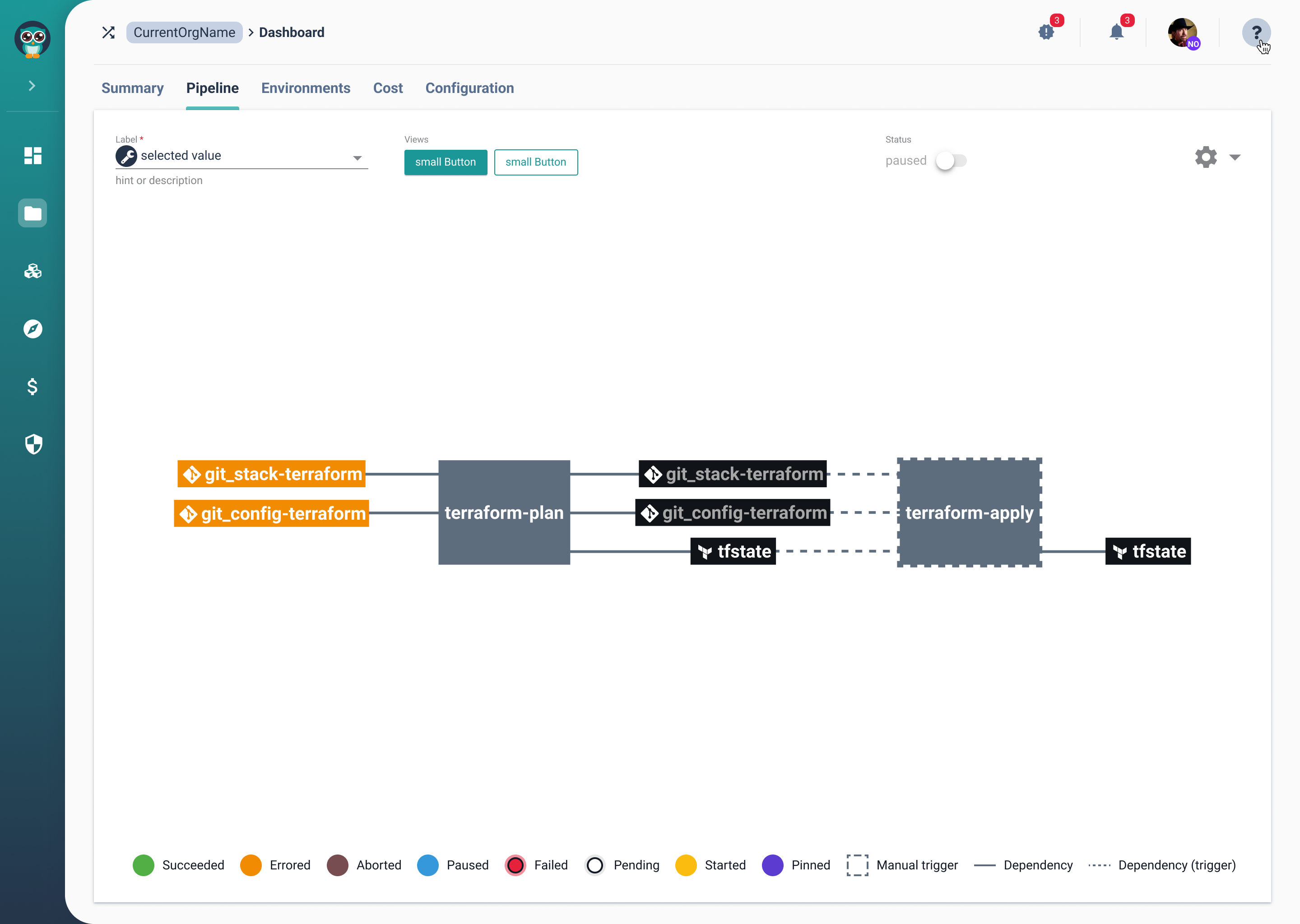
How do you explain complex pipelines to everyone on your team, regardless of skill level? Same as people have been communicating since the dawn of time - pictures! You might already be using multiple tools to keep track of it, but a true DevOps approach can keep it streamlined and visible to all team members. Our CI/CD module centralizes all pipelines and tasks in a single overview that is open to anyone, regardless of technical background. It stays up-to-date and shows clearly every bottleneck so you can get to the crux of the problem faster.
InfraView
-png.png)
Nothing says DevOps superpowers like understanding the ins and outs of your infrastructure setup. InfraView provides a graphical representation of infrastructures deployed in your project's different environments and inspect the Terraform state information for each instance. The goal is simple: build bridges between teams by providing maintenance-free and up-to-date diagrams that everyone can understand.
Bottom line
Upskilling developers or “shift left” is a strategy that can either endanger or supercharge your software delivery. It’s important to make sure that team members - including management - are prepared for it in advance. There’s no reason to throw your teams into the sea of knowledge and hope they’ll make it - at least throw them some rafts!
That’s why Cycloid focuses on building tools that encourage new knowledge, cross-role behavior, and open communication in teams. After all, if you give your teams the instruments to grow their expertise, it will have a direct impact on the success of your company.
If you’d like to read more about the link between upskilling and developer experience, you’re in luck - we’ve written an ebook just for you! Download it through the link below:
{{cta('d7401fb5-1767-46c5-a9c4-09dda5f8e850','justifycenter')}}
...“Adapt or become irrelevant!” is the motto of digital and IT transformation.
Just as IT organizations are under enormous pressure to remain afloat in a tough economy, traditional MSP/SI and IT consultancies also face shrinking margins. While they still hold the higher ground in terms the latest technical expertise, improved security, and cost optimization, the demands of the industry are even higher - and IT consultancies now have to compete with the major cloud providers that have vastly extended and matured their offerings.
Seasoned service providers are opting out for a better solution and partnering up with platforms that can handle the growing demands for DevOps, automation and cloud management - often called internal developer platform or IDP. A platform that supports remote access and collaboration, strong security, multi-cloud monitoring and management and automation is instrumental in IT operations today - and would be an invaluable resource for service providers.
Orange Cloud for Business, a subsidiary of Orange Business Services that manages applications, middleware, and operating systems for third parties, has already chosen improved governance, team collaboration and enhanced customer visibility with Cycloid, the DevOps and hybrid cloud platform. They report 4x faster operations, improved customer service and reduced human error - and this is just the tip of the iceberg.
Time is of the essence. Here’s why partnering with an internal developer platform is crucial to an IT consultancy business strategy - both for the clients and internal processes.
Hear from our solution architect:
Attract new customers
There is a gross overabundance of tools and solutions on the market - an average developer uses up to 28 tools daily. There’s certainly a need to simplify and streamline. That’s why a comprehensive developer platform that acts as a cornerstone to multi-and hybrid cloud monitoring, automation, and team collaboration can be the make-or-break element in an IT company’s success.
Any MSP/SI that has such a solution in its portfolio will look like an attractive candidate. Take a look at Cycloid’s self-service portal, automation, and built-in FinOps modules - can you imagine your customers’ eyes lighting up with excitement? We can because we’ve seen it.
.png)
Speed up build time
What are the main speed bumps when it comes to time-to-delivery? Setting up automation, environment configuration, and - you guessed it - tickets. When your own DevOps engineers have to spend time dealing with repetitive tasks instead of focusing on their core duties, this is going to put obstacles in your delivery process.
A developer platform focused on fostering a culture of automation and reusability will allow you to free your DevOps team from the mundane day-to-day. A built-in service catalog of pre-configured environments will alleviate the pressure from your DevOps and allow end-users to service themselves independently.
Not only will this maximize your own operational efficiency, but your customers will also find it an attractive prospect - who wouldn’t want to boost time from design to presales to production?
Balance control
Transparency is becoming a must-have quality for service providers as IT infrastructure gets closer to the business side.
A unified cloud monitoring and management platform is necessary to get the high-level view that business alignment requires. Modern platforms should also show relationships between a business service and the underlying infrastructure components, to help prioritize and speed the resolution of issues.
Just as complete observability and transparency are crucial, proper governance also plays a major role. A good platform should be able to do just that - open up your automation to customers without sacrificing the necessary control.
Upskill your team
Businesses are starting to see the importance of team transparency, hybrid cloud adoption, IaC rollout, and using DevOps best practices - and the consultancy must be able to answer these demands. But is building a new IDP every time a customer requires it the right move?
Partnering with an IDP will free up your team to work on innovative custom solutions for your clients, while also upskilling them in all the important matters (like hybrid cloud and DevOps best practices!). Here at Cycloid, we feel very strongly about upskilling that’s why we’re releasing an ebook about the link between upskilling and DevX. Subscribe to our newsletter to be notified when it’s out (we promise no spamming!)
Conclusion
There’s value in partnering with experts instead of doing everything yourself. A well-developed IDP with a wide range of features and positive results might suit your customers’ needs better than a platform built from scratch. Not to mention it will need maintenance and upkeep which would take your own talent away from their core tasks, like supplying excellent IT support to your clients.
Cycloid is a partner-first organization that helps partners become strategic cloud advisors, help clients rationalize and simplify technology stacks, become automation experts, and enable client innovation.
.png)
{{cta('2fa281d7-afe7-428b-94b2-6e02f8188729','justifycenter')}}
...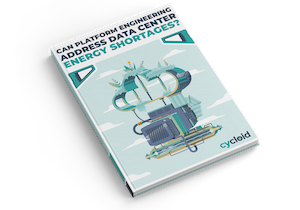
Can Platform Engineering address data center energy shortages?
In this eBook, we dive into how platform engineering can play a pivotal role in tackling the energy crisis faced by data centers.

The Art of Platform Engineering
This ebook will clear up any confusion you may have between Platform Engineering, Internal and self-service portals.

The Definitive Guide to GreenOps
This ebook will be your roadmap to success in a world where environmental responsibility takes center stage.

Guardians of the Cloud: Volume 2
Part 2 of our comic book sees the start of an environmental rebellion and attempts to use cloud resources more efficiently.
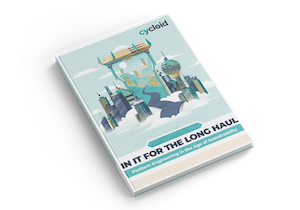
In It For The Long Haul: Platform Engineering in the Age of Sustainability
Enable smarter, more environmentally conscious cloud consumption decisions at every level of a business, and more efficient processes for your teams.

Guardians of the Cloud: Volume 1
Welcome to Guardians of the Cloud, a brand-new comic book series that takes you on an unforgettable journey to Cloud City – a place of endless innovation that harbors a deep secret.

Life in the fast lane: DevOps and hybrid cloud mastery
In this ebook, we show you how to roll out DevOps and hybrid cloud at the same time, while taking as few risks as possible.

IAC Migration for forward-thinking businesses
Read how to alleviate some of your infra-related anxieties with a simple tool. Here are the answers to some of your most burning questions.
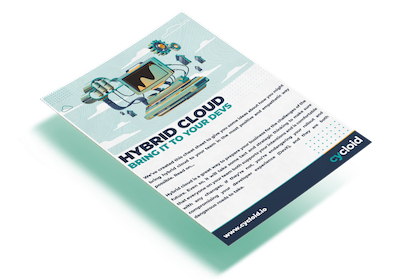
Infosheet: hybrid cloud - bring it to the devs
Are you a team leader, tasked with bringing hybrid cloud to your team? We’ve put together 5 practical, actionable tips to make the rollout easier and the DevX smoother

Life in the fast lane: DevOps and hybrid cloud mastery
In this ebook, we show you how to roll out DevOps and hybrid cloud at the same time, while taking as few risks as possible.

Insight: Businesses need to start thinking about that DevX Factor
We believe that you should empower your existing teams to reach their full DevOps potential. How to deliver that DevX factor – insight by Rob Gillam.
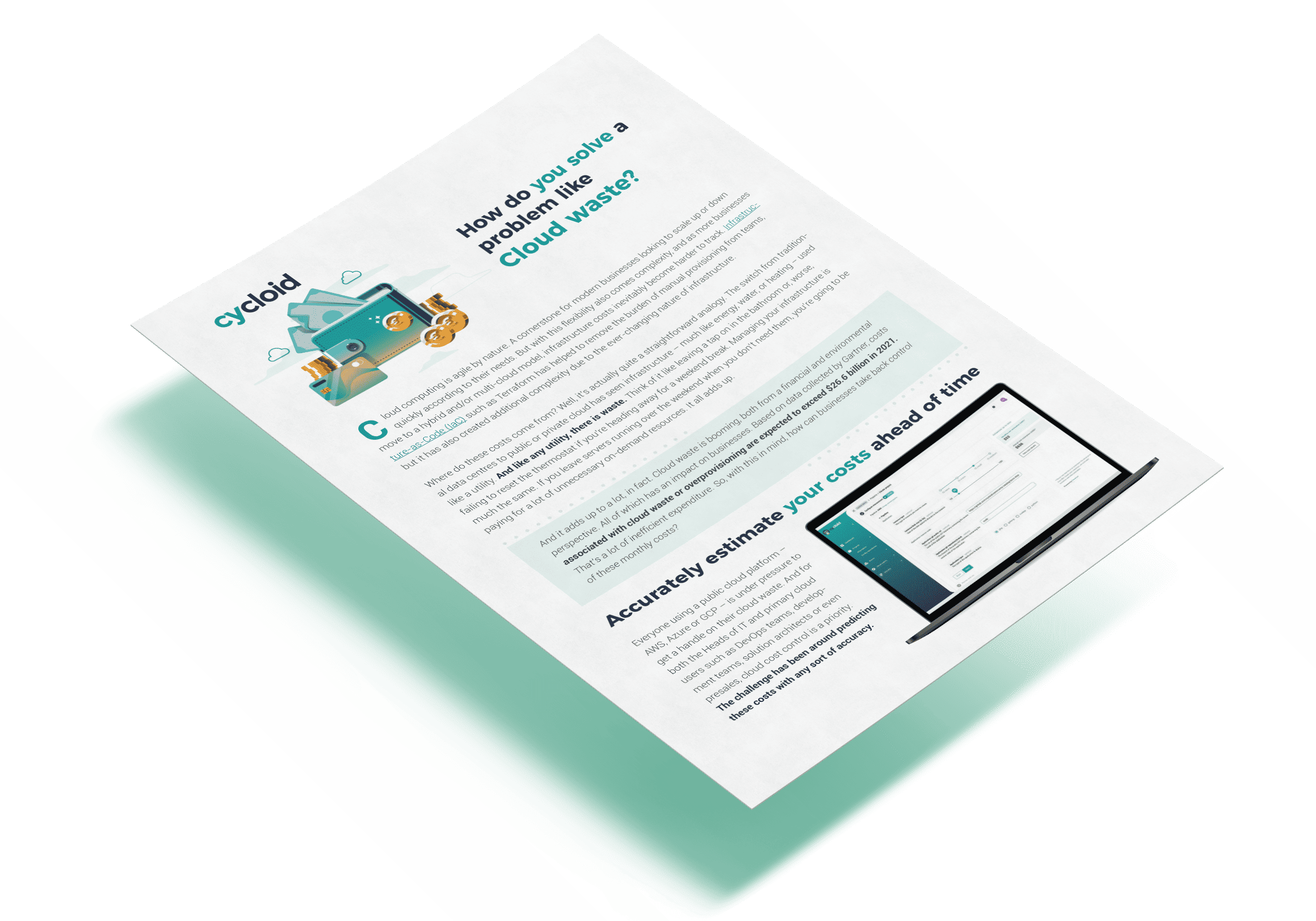
Insight: How do you solve a problem like Cloud Waste?
Without supervision, running cloud expenses will add up and cost you success. Read about Cycloid’s solution to cloud cost estimation and monitoring – insight by founder Benjamin Brial.

Infosheet: Infra as Code by Cycloid
We believe Infra as Code is the only approach to software development that lets you scale safely and successfully, so let us soothe your concerns and lead you confidently into the wonderful world of IaC with this infosheet.

Infosheet: Governance with Cycloid
We know, we know. Governance isn’t cool, but it is essential! Cycloid builds it in from the ground up, so your experts have all the control they need, without cramping the style of the rest of your team. This infosheet explains our approach and what tools you’ll have at your disposal.

Cheatsheet: DevOps business value - make the case to the c-suite
It’s not the message that needs to change, it’s the way you deliver it! We’ve created an infosheet with a new perspective on sharing DevOps and tech metrics with a non-tech audience.

Ebook: DevOps business value: prove it or lose it
We’ve written this ebook to help tech team leaders create better, more productive relationships with the executive team, even if you’ve really had problems communicating in the past.

Whitepaper: Get Your Team Ready for Increased Automation
This whitepaper consolidates the 3 ebooks that make up the hugely popular Plan Now, Win Later ebook series and will show you how to lead your tech team into a DevOps-first future!

Ebook: Build a culture of operational safety
DevOps will help you scale, but scaling is dangerous if you have no safeguards in place. This ebook shows you how to keep your SDLC safe, no matter what.

Ebook: Make tools and schedules work with your team
The grind – or smoothness – of their daily work is what’s going to make or break your team. Set them up for success from day one – we show you how in this ebook.

We talk to Wilco Burggraaf, Green IT lead at HighTech Innovators, to shine the spotlight on the world of Green Coding – a transformative approach that prioritizes energy efficiency.

We sat down with Sean Varley, Chief Evangelist and VP of Business Development at Ampere to discuss the intersection of AI, cryptocurrency, and sustainable technology.

Donal Daly, the visionary founder of Future Planet, joins us this time and takes us on a compelling exploration into the realm of ESG (Environmental, Social, and Governance) strategies.

We talk to Guillaume Thibaux, Founder & CTO of Quanta.io, shining the spotlight on his visionary company that has pioneered a free solution to measure the environmental impact of a website.
Coming soon!

Up Next!
Keep an eye on this page to view upcoming episodes.
Next Episode Launch date: February 2025
Product demos
Cycloid Platform Engineering Demo Video
Improve developer experience, empower end-users and operational efficiency to increase time-to-market speed with Cycloid.
Improve DevX with Cycloid Platform Engineering
Cycloid Platform Engineering uses a simple user-friendly self-service portal and service catalog to empower your end-users.
Feature demos
Calculate the cost of resources before you deploy - Cloud Cost Estimation Tool
Cloud Cost Estimation is integrated within our developer self-service portal Stackforms to help you make the best cost-optimized decisions before you deploy.
Simple service catalog - Stacks
Preconfigure user-friendly Stacks and allow your devs to choose approved and suitable infra configurations from a custom service catalog that’s made to measure.
Reverse Terraform tool: Infra Import 2024
Infra Import industrialises your manually deployed infrastructure at scale by automatically creating Terraform files and generating IaC. Modernize your infra and future-proof your business with Cycloid.









